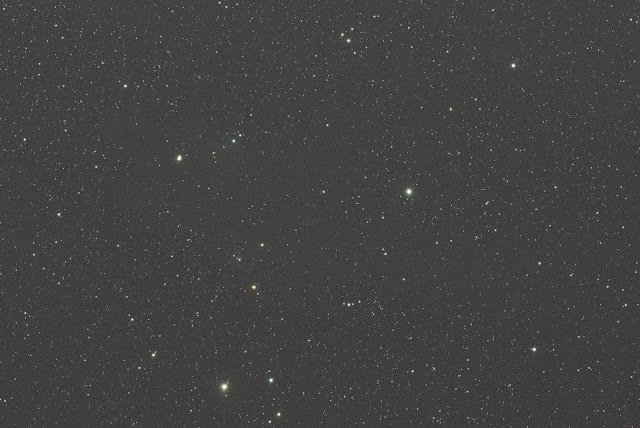Smile you Son of a ...
 |
| LDN 1235 - The Dark Shark Nebula captured on 9/14/2023 & 9/15/2023 |
This never happens!!! Two clear nights in a row at New Moon!!! Thursday (9/14) and Friday (9/15) were predicted to be clear, with no Moon. Therefore, wanted to go after something that was a challenge or stretch target for me and my Bortle 4/5 location, The Dark Shark Nebula. This target is very faint and requires dark skies and lots of exposure. I have pretty good skies, around Bortle 4 or 5, darker skies would be better, but figured I would give it a go.
Wednesday, I framed up the image using Telescopius (telescopius.com) because I wasn't able to find this object in the NINA Sky Atlas. One advantage of Telescopius is that it allows you to adjust the brightness of the image being displayed. Increasing the brightness made the Shark visible, an advantage when framing the image. I imported the coordinates into the NINA Framing Assistant and then created a Sequence so I would be ready to go Thursday night. I still use the Legacy Sequencer, although I'm preparing to give the Advanced Sequencer a try. Will use a night with a bright Moon to experiment (not risking clear nights at New Moon).
Thursday, after getting home from work, I quickly set up my imaging rig. Things went smoothly. Polar aligned with SharpCap Pro and calibrated the guiding software (PHD2) once skies were dark enough. Started collecting subs at 8:43 PM. Individual 2-minute sub exposures (subs) did not show any hint of the Shark, even with a screen stretch. I decided to keep collecting exposures without a change because I was shooting to the North, there's lots of light pollution to my North. Examining the subs and looking at the histogram led me to the decision to keep exposure as is. My hope was by getting enough exposures, I would be able to get the Shark. I stopped imaging at 2:23 AM, when the target would be lost to the trees. Was able to collect 130 subs on night 1. NINA parked my scope and warmed the camera. I got up earlier the next morning to bring in my laptop and cover my rig with a tarp.
 |
| A single 2-minute exposure (calibrated and debayered) with an unlinked auto stretch applied (no other processing). Do you see the Shark? |
I got a later start on Friday night as I tried (unsuccessfully) to catch Comet C/2023 P1 Nishimura at sunset. Started capturing exposures at 8:54 PM. Conditions were very good again and the imaging session went smoothly. The session ended at 2:31 AM. A total of 139 exposures were captured. NINA parked the scope and warmed the camera. Retrieved my laptop in the morning and waited until late morning to put my equipment away, as everything was covered in dew. Saturday was forecast to be cloudy. Even if it was clear, I would not have been able to image due to family a commitment.
Image Processing
All pre and post processing was done in PixInsight. All 269 sub exposures were evaluated with Blink and the Subframe Selector process. After this evaluation, 36 sub exposures were discarded. The remaining 233 subs were loaded into the Weighted Batch Pre-Processing Script (WBPP) along with the associated calibration (Darks, Flats, & Flat Darks) frames. This represents a total of 7 hours and 46 minutes of total exposure. I enabled 2X Drizzle Integration. This is the resulting Master Light unlinked auto stretch applied (no other processing).
 |
| Master Light from WBPP. Can you start to see the Shark now? |
Linear Processing: Automatic Background Extraction (ABE), Sprectrophotometric Color Calibration (SPCC), RC-Astro's BlurXTerminator (BXT), RC-Astro's NoiseXTerminator (NXT), and the image was made non-linear with Histogram Transformation (HT).
Non-Linear Processing: RC-Astro's StarXTerminator (SXT). Stars: Saturation was enhanced with Curves Transformation (CT) and Green Noise was removed with SCNR. Starless: Another application of NXT, the Image was brightened, and contrast was enhanced with multiple applications of CT. A mask was applied, and Saturation was enhanced with CT. Mask was removed and SCNR was applied. Local Histogram Equalization (LHE) was applied at 3 different Kernel sizes followed by Multiscale Median Transform (MMT). Dark Structure Enhance script (DSE) was used and the Stars were screened back in with pixel Math. The image was resampled down by 50% with the Resample process (making the file size a little more manageable). The image was processed 6 different times using the above process/scripts with slightly different setting each time, until the final (for now) image at the beginning of this post was obtained.
What is it?
The Dark Shark is located in a section of the Milky Way that contains a lot of interstellar Dust and Gas. This object is comprised of interstellar dust and gas. Powerful winds radiating from massive stars create the "structure" or shape of this object.
 |
| An annotated version of the image |
How big is it?
This Shark is about 15 light-years (ly) from head to tail.
How far is it?
It is located about 650 light-years (ly) from Earth in the Constellation Cepheus.
How to find it?
I'm honestly not sure if this object can be observed visually, if it can be observed, assuming this would be a very challenging target. My gut says this can't be visually observed. This object is located in the Constellation Cepheus. To me, it looks like a house. The Dark Shark Nebula is location is indicted by the red rectangle in the finder chart below.
 |
| Finder Chart for Dark Shark Nebula |



















